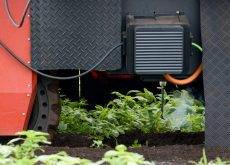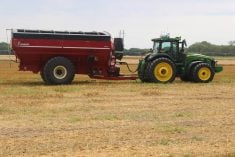It’s June 9. Seed alone costs $80 per acre; total inputs cost $400 per acre. Is it worthwhile to make a mess of your land? Can you harrow and spray on time? Plus, it’s already a short season.
When you consider all these factors, is it worth the gamble to seed canola?
Some canola growers on the eastern Prairies may still be trying to decide if they should broadcast seed or wait for better drying days, or simply write off those acres.
Canola prices will be high in the fall and most inputs may already be in the ground, but with saturated soil, do you have confidence you can harvest a profitable canola crop this fall?
Read Also

Research looks to control flea beetles with RNAi
A Vancouver agri-tech company wants to give canola growers another weapon in the never-ending battle against flea beetles.
It’s a difficult question and one that some advisers were reluctant to answer on June 3.
But canola council agronomist Angela Brackenreed stepped up to the plate.
In a phone interview, she said there’s no rule of thumb guiding what to do and there’s no way to predict success.
“I’ve seen broadcast canola crops with survival way under 50 percent,” said Brackenreed, who farms at Justice, Man.
“I’ve seen survival of broadcast canola all the way up to 90 and even 100 percent. Every seed dropped on the field germinated and survived. You don’t get that with the best drill.
“In this scenario, they broadcast, did a light incorporation then got a light rain and everything was pretty much perfect. We bumped the seeding rate quite a bit because we expected poor survival, so of course that helped also.”
Brackenreed said seed-to- soil contact is essential to achieve any kind of crop with a harrow or shallow cultivation. If you broadcast today, you know that you’re already facing a short growing season. A higher seeding rate helps move that crop along. The same suggestions apply whether you seed with a Valmar, airplane or helicopter.
“The most common setup, and probably the best-case scenario, is a Valmar with a harrow dragged directly behind. Looking at the classifieds this past couple weeks, suddenly there’s a bunch of harrows on the market. People who have a set they don’t need realize there’s a big demand.
“Right now, all we can do is do what we can and hope Mother Nature is kind to us.”
Canola council agronomy director Clint Jurke said before blowing on the seed, a grower should take a real good look at the numbers.
“If you can’t drill your seed into good soil conditions, than your yield expectations will certainly be impacted. And you also have the additional cost of trying to manage a poor canola stand through the season,” said Jurke in a phone interview.
“With a weak stand, you can count on additional herbicide costs. You’ll have some areas you can harrow and other areas you can’t get close to, so that means maturity will be very uneven. That impacts your fungicide application. At the other end of the season, you can start to get risk of frost and a very tough crop with highly variable moisture content.
“I wouldn’t say I’m against broadcasting canola. I’d only say that a grower has to set realistic expectations.”


















